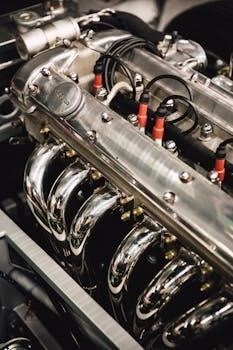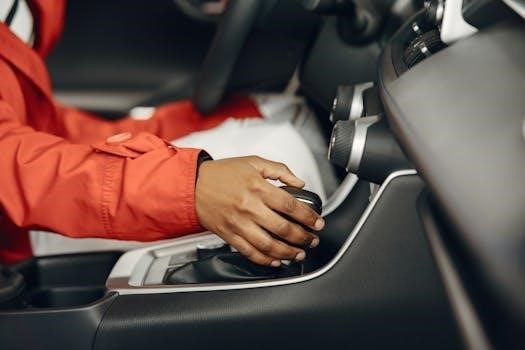manual or automatic driving lessons
- by leo

Deciding between manual and automatic driving lessons is a key step for new drivers. Each option offers unique experiences regarding ease, control, and long-term driving habits. Understanding these differences is essential before starting your driving journey.
Overview of the Choice
The choice between manual and automatic driving lessons often sparks debate, as each caters to different needs and preferences. Manual lessons traditionally offer a more hands-on experience, requiring drivers to master gear changes and clutch control. This can be more engaging but also more challenging for some learners. Conversely, automatic lessons simplify the driving process by removing the need for manual gear shifting, often leading to a smoother and less stressful learning curve. This difference impacts not only the initial learning phase but also the type of vehicles drivers can operate post-licensing. Ultimately, the best choice depends on individual comfort levels, future driving goals, and how you adapt to changing road conditions.

Manual Driving Lessons
Manual driving lessons involve learning gear changes and clutch control, offering a more engaging driving experience. This approach demands more coordination but provides a greater sense of control.
Advantages of Manual Lessons
Manual driving lessons offer a significant advantage in vehicle control, allowing drivers to precisely manage power and speed, especially in challenging road conditions. This increased control can be crucial in varied driving scenarios, enhancing the overall driving experience. Furthermore, manual cars are generally more cost-effective to purchase and maintain, leading to potential long-term savings. Learning to drive a manual car also equips drivers with the skills to operate both manual and automatic vehicles, providing more flexibility. The engagement of shifting gears can be more stimulating for some, making driving a more active and connected experience. Manual transmission often provides a better understanding of how a vehicle operates mechanically, fostering a deeper connection with the car. This understanding can lead to more fuel-efficient driving habits, as drivers are more aware of the engine’s performance and requirements. Additionally, having a manual license gives the driver the freedom to drive any type of vehicle.
Disadvantages of Manual Lessons
Manual driving lessons can present several challenges, especially for beginners. The coordination required between the clutch, gear stick, and accelerator can be difficult to master, demanding more practice and patience. Shifting gears while driving in heavy traffic can be tiring and frustrating, often requiring constant attention and quick reflexes. Learning to find the biting point and performing smooth hill starts can be particularly daunting for new drivers, adding to the overall learning curve. This complexity can also lead to more stress and distraction, potentially increasing the time needed to pass a driving test. Additionally, some drivers may find manual cars less comfortable to drive, especially those with coordination issues or those who want a relaxed driving experience. The added workload of manual driving can make commuting less appealing, and it may be a deterrent for those who prefer a smoother and less engaging style of driving. The need to master clutch control might lead to more stalling situations early on in lessons.
Automatic Driving Lessons
Automatic driving lessons offer a simpler approach by removing the need for manual gear changes. This can make learning easier and faster, appealing to many new drivers.
Advantages of Automatic Lessons
Automatic driving lessons present several advantages, particularly for beginners; The most significant benefit is the ease of learning; without the need to coordinate clutch, gear changes, and accelerator, new drivers can focus more on road conditions, traffic, and safety. This reduced cognitive load can lead to a less stressful learning experience and potentially quicker progress. Automatic cars also eliminate the risk of stalling, making hill starts and stop-and-go traffic less daunting. This simplicity often translates into fewer lessons being needed, potentially saving time and money. Furthermore, automatic transmissions are becoming increasingly common in modern vehicles, making this skill more relevant for many drivers.
Disadvantages of Automatic Lessons
While automatic driving lessons offer ease, there are some notable disadvantages. Primarily, automatic licenses restrict drivers to automatic vehicles only; they cannot operate manual cars without further training and testing. This limits vehicle choice and might affect car availability or affordability, as automatics can be more expensive to buy and maintain. Some drivers also find the driving experience less engaging, lacking the sense of control and connection with the vehicle that comes with manual gear changes. Furthermore, repairs for automatic transmissions are often more complex and costly, potentially leading to higher running costs. This lack of versatility can be a significant drawback for some drivers.
Cost Considerations
The financial aspects of learning to drive vary between manual and automatic lessons. Initial lesson costs, vehicle purchase prices, and insurance premiums may differ significantly, affecting your overall budget.
Lesson and Vehicle Costs
When considering the costs, it’s important to note that manual driving lessons are generally cheaper per session, but may require more lessons overall due to the complexity of mastering gear changes and clutch control. Automatic lessons might be pricier per hour, yet learners could need fewer sessions, potentially leading to quicker test readiness. However, the purchase price of automatic vehicles tends to be higher, which can affect long-term ownership costs. Furthermore, insurance premiums can sometimes be more expensive for automatic cars, influenced by repair costs and vehicle value. Choosing between manual and automatic isn’t just about lesson fees but also about the total vehicle and insurance expenses you will incur.

Test and Licensing
The type of license you obtain is directly tied to the transmission type you learn on. A manual license allows you to drive both, while an automatic license restricts you to automatics only.
License Restrictions
A crucial aspect to consider when choosing between manual and automatic driving lessons is the license you will receive upon passing your driving test. If you successfully complete your driving test in a manual vehicle, you will be granted a full driving license, which permits you to operate both manual and automatic cars. However, if you take your lessons and pass the test in an automatic vehicle, your license will be restricted. This restriction means you are only legally allowed to drive automatic cars. This limitation can be a significant factor for individuals who desire the flexibility to drive any type of vehicle in the future; Choosing manual lessons, while initially more challenging, can provide greater freedom with future vehicle choices. The decision should therefore be made after careful consideration of long-term needs.

Long-term Driving Preferences
Long-term driving preferences play a crucial role in choosing between manual and automatic lessons. Consider whether you value control and versatility or prioritize ease and convenience for your future driving.
Versatility and Control
Manual transmissions offer drivers increased control over the vehicle’s power and speed, allowing for precise handling in various conditions. This versatility enables drivers to adapt to different terrains and driving scenarios, enhancing their overall driving experience. Learning manual provides a deeper understanding of the vehicle’s mechanics and how it responds to driver input. This knowledge can be beneficial in challenging situations. Moreover, a manual license permits driving both manual and automatic vehicles, offering more flexibility in car choices. However, this added control requires more coordination and can be more demanding. Ultimately, it provides a more engaging and connected driving feel for many.

Making the Right Choice
Choosing between manual and automatic lessons depends on individual needs, preferences, and long-term goals. Consider your comfort level, budget, and the type of driving you plan to do.
Factors to Consider
When deciding between manual and automatic driving lessons, several key factors should be taken into account. Firstly, consider your personal comfort and coordination levels; manual driving requires more precise control over the vehicle, while automatic is generally easier to learn initially. Secondly, think about the potential costs involved, both for lessons and future car ownership; manual cars and lessons might be cheaper, but automatic lessons could mean fewer sessions overall. Thirdly, assess your long-term driving preferences, such as the desire for greater vehicle control versus convenience. The type of car you intend to drive regularly and the potential for needing to drive manual vehicles are also important aspects to think about. Finally, consider the level of stress and distraction you’d prefer to manage while learning, as automatic transmissions can reduce the learning curve.
No related posts.
Ready to ditch the L-plates? Get expert manual or automatic driving lessons and become a confident driver. Let’s get you on the road!
Posted in United Kingdom